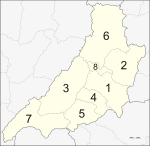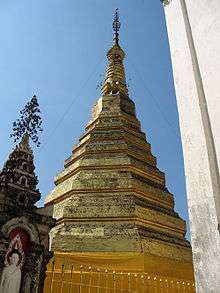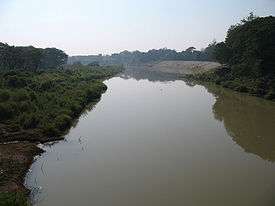Phrae Province
| Phrae แพร่ | ||
|---|---|---|
| Province | ||
|
| ||
| ||
 Map of Thailand highlighting Phrae Province | ||
| Country |
| |
| Capital | Phrae town | |
| Government | ||
| • Governor | Watthana Phutthichat (since October 2016) | |
| Area | ||
| • Total | 6,538.6 km2 (2,524.6 sq mi) | |
| Area rank | Ranked 32nd | |
| Population (2014) | ||
| • Total | 454,083 | |
| • Rank | Ranked 48th | |
| • Density | 69/km2 (180/sq mi) | |
| • Density rank | Ranked 57th | |
| Time zone | ICT (UTC+7) | |
| ISO 3166 code | TH-54 | |
Phrae (Thai: แพร่; pronounced [pʰrɛ̂ː]) is one of the northern provinces (changwat) of Thailand.[1] Neighboring provinces are (from north clockwise) Phayao, Nan, Uttaradit, Sukhothai, and Lampang.
Geography
Phrae is in the valley of the Yom River. The Phi Pan Nam Range runs across the province from north to south in the west. The Phlueng Range is in the east.
History
The history of Phrae dates back to the Haripunchai kingdom of the Mon. It became part of the Lannathai kingdom in 1443, when King Tilokaraj was on an expedition to capture Nan.
Symbols
Provincial seal: According to legend the two cities of Phrae and Nan were once ruled by brothers. When they met to divide the land between them the one from Phrae rode on a horse, the one from Nan on a buffalo to the meeting point on top of a mountain. Hence Phrae uses a horse in their seal, while Nan uses a buffalo. When the provincial government proposed the seal in 1940, the Fine Arts Department suggested adding a historic building to the seal in addition to the horse, thus it now has the stupa of Phra Tat Cho Hae on the back of the horse. This temple is about nine kilometers southeast of the city of Phrae.[2]
The provincial flower and tree is the Burmese Almondwood (Chukrasia tabularis).
Administrative divisions

The province is subdivided into eight districts (amphoe). These are further subdivided into 78 subdistricts (tambon) and 645 villages (muban).
Tourism

Sights
Wat Luang (วัดหลวง) Some of its major features include the viharn and Chiang Saen-style chedi enshrining a holy relic brought over from Myanmar. Others are the museum housing various antiquities including several 500-year-old Buddha statues and an ancient Lanna-style wooden structure.
To the west of Wat Luang is Wat Phra Non (วัดพระนอน) near the site of the old city walls. Some of the architectural works include the Chiang Saen-style ubosot with narrow openings to let in light instead of normal windows. Inside is a 9-metre-long plaster reclining Buddha.
Wat Phra Bat Ming Mueang (วัดพระบาทมิ่งเมือง) was built in 1955 by combining two ancient temples. There is an old chedi containing a replica of the holy footprint inside.
The City Pillar Shrine of Phrae (ศาลหลักเมืองแพร่) features an inscription stone with ancient Thai scripts of the Sukhothai period describing the construction of a temple in the town.
Wat Sa Bo Kaeo (วัดสระบ่อแก้ว) is a temple with several exotic Burmese artistic-styled structures and Buddha statues. It is also where Burmese monks who travel to Thailand to study the Buddhist scripture stay.
Wat Chom Sawan (วัดจอมสวรรค์), a Burmese-style temple. Antiquities found here include marble Buddha statues, statues made of woven bamboos coated with lacquer, and Buddha statues made from ivory, as well as ivory scripture slabs with Burmese scripts.
Ban Thung Hong (บ้านทุ่งโฮ้ง), a village noted for the making of products made from Mo Hom (ม่อฮ่อม) material. It is a local cotton fabric dyed in blue which is used in making native and modern clothing.
Ban Rong Fong (บ้านร่องฟอง) specialises in making metal agricultural tools using traditional production methods.
Ban Pong Si (บ้านโป่งศรี) at tambon Thin of mueang district is a village which collects and exchanges second-hand household utensils for daily use.
Phae Mueang Phi (วนอุทยานแพะเมืองผี) is a wide area with no large trees. Because of subsidence and erosion of the soil, the harder elements remain and are formed into the shapes of exotic-looking mushrooms.
A small, two-level waterfall, Namtok Mae Khaem (น้ำตกแม่แคม) is located at Tambon Suan Khuan. There is another fall, larger and with three levels, in the vicinity. It is Namtok Tat Mok (น้ำตกตาดหมอก), which is about 22 kilometres from town.
Wat Phra That Cho Hae (วัดพระธาตุช่อแฮ) is a major religious site of the province. It was built in the time of Sukhothai. The 33 metre-tall Chiang Saen-style chedi housed a holy relic. It was built of bricks and covered with bright brass sheets.
Wat Phra That Chom Chaeng (วัดพระธาตุจอมแจ้ง) is a golden chedi that is 29 metres tall and enshrined a holy relic. There is also a museum of rare ancient relics.
Phraya Chaiyabun Memorial (อนุสาวรีย์พระยาไชยบูรณ์) honors the man who was governor of the town during 1897-1902. He was slain by rebelling Shan tribesmen when he refused to cede the town to them. After the rebellion was put down by government troops, King Rama V ordered a memorial erected in his honour.
Folklore Museum (พิพิธภัณฑ์พื้นบ้าน), in the same compound as the Ban Fai garden restaurant (สวนอาหารบ้านฝ้าย), is made up of several buildings and wooden structures displaying the local way of life. The different types of wooden houses demonstrate the different status of the local people.
Hua Dong Market (ตลาดหัวดง) is the centre of products made from wood and rattan, mostly household furniture and decorative items.
Wat Phra Luang (วัดพระหลวง) features a Sukhothai-style chedi and is referred to by the local people as "That Neong" (ธาตุเนิ้ง), meaning the leaning chedi.
Wat Phra That Suthon Mongkhon Khiri (วัดพระธาตุสุโทนมงคลคีรี) is noted for its delicate sculptures with fine designs. There is also the golden teak structure in the Lanna-style which houses valuable relics of the North, including Buddha statues, lacquer ware, Lanna musical instruments, ancient weapons, and pictures depicting past events.
Kaeng Luang (แก่งหลวง) On the other side of the river is found the Tham Erawan (ถ้ำเอราวัณ) adorned with elephant-and-female-shaped hanging and protruding crops of rock.
Wiang Kosai National Park (อุทยานแห่งชาติเวียงโกศัย) contains two waterfalls, the Mae Koeng Luang (น้ำตกแม่เกิ๋งหลวง), and the Mae Koeng Noi (น้ำตกแม่เกิ๋งน้อย). Streams from the falls flow into the Yom River.
Another interesting cave is Tham Pha Nang Khoi (ถ้ำผานางคอย). At the end of the cave is a stalagmite shaped like a woman holding a small child. In front of the Nang Koi (waiting woman) stone is a heart-shaped stalactite. They are the source of the legend of the love of a woman who waited for her lover until she turned into stone.[3]
Phra That Phra Lo (พระธาตุพระลอ) is a 400-year-old chedi believed to contain the remains of a king named Phra Lo, ruler of Nakhon Maen Suang once located in the vicinity. It is said he died together with his two lovers, Phra Phuean and Phra Phaeng.
Local Products
Mo Hom (ม่อฮ่อม) is a well-known hand-crafted fabric made in Phrae. Considered a quality product, using traditional methods in the weaving, dyeing and tailoring processes.
Another famous product is Pha Tin Chok (ผ้าตีนจก), a fine and well-made fabric with distinctive design. Apart from being widely used as material to make dresses, today it is also used to make items such as hand-bags, shoes, and household decorative items.
Culture
Festivals
The Phra That Cho Hae Fair (งานประเพณีนมัสการพระธาตุช่อแฮ), held around March, involves a procession to carry robes to cover the chedi. The procession follows the Lanna style. All participants are decked out in traditional Lanna attire.
Doklomlaengban Songkran Muangphrae Nung Mohhom Tae Ngam Ta or Songkran Festival in Phrae is held on 13–17 April every year at Chareun Muang Road, Yantarakit Kosol Road and around the city.
References
- ↑ "Phrae". Tourism Authority of Thailand (TAT). Retrieved 18 May 2015.
- ↑ "General Information". Phrae Province. Retrieved 18 May 2015.
- ↑ Tham Pha Nang Khoi Archived January 15, 2011, at the Wayback Machine.
- ↑ "Mae Yom National Park". Department of National Parks (DNP) Thailand. Retrieved 18 May 2015.
External links
 Phrae travel guide from Wikivoyage
Phrae travel guide from Wikivoyage
| Wikimedia Commons has media related to Phrae Province. |
- Phrae Province website
- Phrae provincial map, coat of arms and postal stamp Archived October 6, 2010, at the Wayback Machine.
- Knowledge of Encyclopediathai Travel & Country Guides Welcome to Phrae Province
 |
Phayao Province |  | ||
| Lampang Province | |
Nan Province | ||
| ||||
| | ||||
| Sukhothai Province | Uttaradit Province |
Coordinates: 18°8′42″N 100°8′26″E / 18.14500°N 100.14056°E

